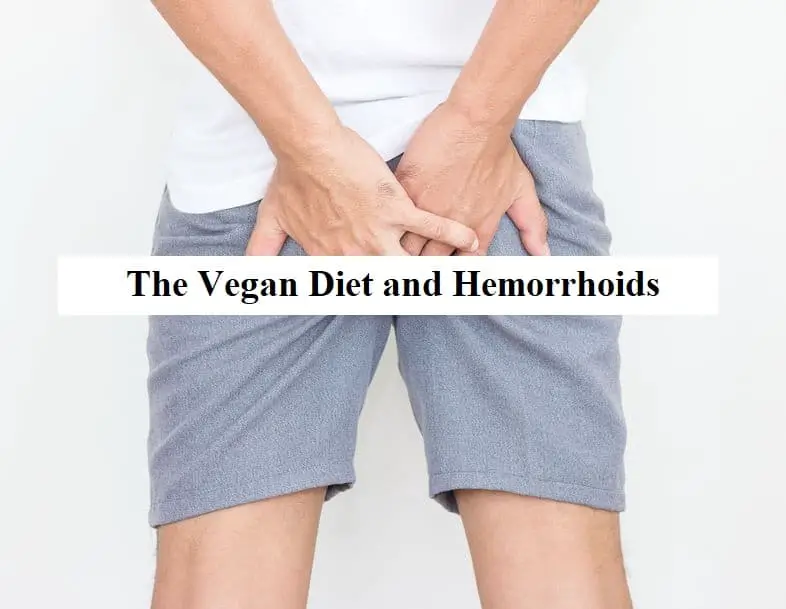This question often comes from folks who are thinking of switching to the vegan diet. Either they suffer from hemorrhoids and wonder if plant-based eating may provide a remedy, or they currently get hemorrhoids and are concerned the vegan diet may exacerbate the problem. So, I thought I would put together this article to lay out the relationship between the vegan diet and this unfortunate condition.
What is the relationship between the vegan diet and hemorrhoids? Does it hurt, does it help, or is it neutral?
The vegan diet is thought to help prevent hemorrhoids and/or alleviate the condition. In The Dietitian’s Guide to Vegetarian Diets, Messina et al. states “Because vegetarians consume 50-100% more fiber than meat eaters, they are less likely to suffer from either constipation or hemorrhoids.”1
I do get asked quite a bit if any specific foods are helpful when it comes to alleviating hemorrhoids. A lot of folks find foods high in insoluble fiber to be effective.
There are certain phytochemical-rich “superfoods” like blackberries that are thought to help with hemorrhoids.
The textbook, Hemorrhoids: a Medical Dictionary, Bibliography, and Annotated Research Guide to Internet References, lists a number of substances that are thought to be useful.10
It’s thought that the rich tannin content of the food may account for the alleviation of hemorrhoids associated with its consumption.11,12
There’s been very little research in this area, but it’s definitely worth a try. Fruits high in phytonutrients provide so many health benefits, so you can’t really go wrong.
If you’d like to know more about the link between the vegan diet and hemorrhoids, then keep reading. But ye be warned! I hope you are low in disgust sensitivity. Just be glad I didn’t make heavy use of images for this article. Keep in mind that vegetarian and even vegan diets are not always followed in a way that optimizes health.
I should note that I go over the following themes in much more detail in the article on constipation. So, if you want a more in depth understanding of the topics covered here, you may want to check that article out.
Plant-based eaters are only buttressed against constipation and hemorrhoids (compared to meat eaters) if they do in fact consume ample amounts of fiber. Don’t worry, I will tell you what you need to know here, including the category of foods that are most effective in the prevention of constipation and hemorrhoids.
What Exactly Are Hemorrhoids?
Hemorrhoids, or piles, are clusters of varicose veins in the anal area that have become inflamed and enlarged. They’re similar to the twisted, swollen veins that appear on a person’s legs with age, or due to pregnancy, etc. They differ both in location and in that they are very uncomfortable, if not downright painful.
The condition is usually not serious—in the life-threatening sense—but it can cause severe discomfort during bouts in which the inflamed veins are particularly swollen. They can occur high in the anal canal (internal hemorrhoids) or low near the anal opening (external hemorrhoids). Most people, when they complain of hemorrhoids, are referring to the latter.
This swelling and inflammation of the rectal and anal veins are due to a few factors.
- The vessels in this area are found in very loose connective tissue.
- As a result, the rectal veins get less support from surrounding tissues.
- Without adequate support, these veins become less effective in resisting increases in blood pressure.2
The Link Between Hemorrhoids and Constipation
The most common cause of hemorrhoid development is straining during bowel movements. It’s at this point, that the obvious role of diet comes in. We strain at stools when we’re constipated. Because constipation often comes about due to poor eating habits, the quality of one’s diet plays a huge role in the development of hemorrhoids.
Of course, constipation isn’t the only cause of straining at stools. Other antecedents include pregnancy, obesity, and people with cirrhosis—due to an increase in the pressure of the veins of the intestine.3,4
The Role of Diet in Preventing Hemorrhoids
As covered previously, constipation is probably the root cause, so eating to reduce the likelihood that one becomes constipated is the best bet in avoiding the development of hemorrhoids.
Constipation is classified as primary or secondary. Secondary constipation is related to medications, organic diseases, and systemic diseases. So, I won’t be addressing secondary constipation here. Primary constipation is where diet comes into play.
Primary constipation can be further broken down into:
- Normal transit—the most common form of chronic constipation. Also known as functional constipation.5
- Slow transit constipation
- Anorectal dysfunction.
When it comes to normal transit constipation, diet is usually implicated. It’s called normal transit constipation because stool passes through the colon at the usual rate of about 5 days in persons with this condition.
Stool frequency is often within the normal range as well. Because the transit is normal, it’s diagnosed in part by patient reports of hard stools, and difficulty defecating.
With this type of constipation, people usually experience abdominal pain or discomfort and bloating. These symptoms usually respond to increasing one’s intake of water and dietary fiber—specifically, the soluble, nonviscous fibers.
This info applies to children as well. In a recent study, it was found that lack of fiber may be a causative factor in chronic constipation in school-age kids.6 Additionally, fiber was found to alleviate symptoms of constipation in a group of children.7
Insoluble Fibers: Your Weapon Against Constipation and Hemorrhoids
As mentioned above, there’s a type of fiber that’s most effective in “keeping things moving.” This type of fiber is semi-fermentable (if at all), and isn’t soluble in water. Think foods with a lot of cellulose, like whole-wheat bread, whole bran cereals, etc. So, what’s so special about this fiber?
There are certain fiber components that are either poorly fermented or not fermentable at all—though this is a contested designation, given that these days it’s thought to be possible that all fiber is at least somewhat fermentable.8

Principally, this type of fiber includes cellulose and lignin, though some resistant starches and plant waxes are also included in this category. There’s also hemicelluloses, which are more on the fermentable side for this type of fiber.
These fibers transit the gastrointestinal tract almost completely unchanged and are then excreted in the feces. Fun (read: irrelevant) fact: you’ll notice that when you consume good quantities of this type of fiber, your stool tends to be higher in volume—fecal volume, they call it.8
This information is to be contrasted with that of soluble, rapidly fermentable fibers, such as those found in fruit. You may have noticed that certain fruits, when blended in water (when making smoothies, etc.), tend to really gel up.
This is because the fiber in fruit (specifical pectin) has the property of being viscous—it’s not grainy like the fiber in whole bran.
These are not arbitrary distinctions. As mentioned above, insoluble fibers in foods like whole grain bread speed up intestinal transit and reduce the likelihood of constipation. However, the type of fiber in fruit—the stuff that really gels up—has the opposite effect. It actually SLOWS down intestinal transit time—which is exactly what you don’t want.
That’s right, generally soluble fibers delay (lengthen) transit time of the small intestine, whereas insoluble fibers do the opposite—they speed up (shorten) transit time within the small intestine.9
Now, that doesn’t mean you should avoid these foods. They’re still very healthy. It’s just good to keep in mind that you want to make sure and include a wide variety of high-fiber foods in your diet.
That’s it for hemorrhoids. Thanks for reading.
You may also want to check out the following articles:
- The Vegan Diet and Constipation: Everything You Need to Know
- Gas and Bloating on the Vegan Diet (Causes, Remedies)
- The Vegan Diet and Diarrhea (Causes, Remedies)
References
- Mangels R, Messina V, Messina M. The Dietitian’s Guide to Vegetarian Diets: Issues and Applications. Jones & Bartlett Learning, 3 ed. 2010.
- Hemorrhoids: a medical dictionary, bibliography, and annotated research guide to Internet references James Parker-Philip Parker – Icon Health Publications – 2003
- Hemorrhoids in pregnancy. https://www.ncbi.nlm.nih.gov/pmc/articles/PMC2278306/
- Gastrointestinal dysfunction in liver cirrhosis. https://www.ncbi.nlm.nih.gov/pmc/articles/PMC4209534/
- Christopher N Andrews and Martin Storr. The pathophysiology of chronic constipation. Can J Gastroenterol. 2011 Oct; 25(Suppl B): 16B–21B.
- Rome E, Adamidis D, Nikolara R, et al. Diet and chronic constipation in children: the role of fiber. J Pediatr Gastroenterol Nutr. 1999;28(2):169-174
- Tse PW, Leung SS, Chan T, et al. Dietary fiber intake and constipation in children with severe developmental disabilities. J Pediatr Child Health. 2000;36(3)236-239.
- Gropper, Sareen S; Smith, Jack L. Advanced Nutrition and Human Metabolism (Page 123).
- Gropper, Sareen S.; Smith, Jack L. Advanced Nutrition and Human Metabolism (Page 119).
- Hemorrhoids: a Medical Dictionary, Bibliography, and Annotated Research Guide To Internet References (Page 56). James Parker-Philip Parker – Icon Health Publications – 2003
- Cloverleaf Farm, Inc; c2014. [Last accessed on 2013 Sep 06]. cloverleaffarmherbs.com [Internet] Available from: https://www.cloverleaffarmherbs.com/blackberry/#sthash.0%C3%97JqXObG.dpbs
- Foods. http://www.wholehealthmd.com/main/foods/110.aspx

